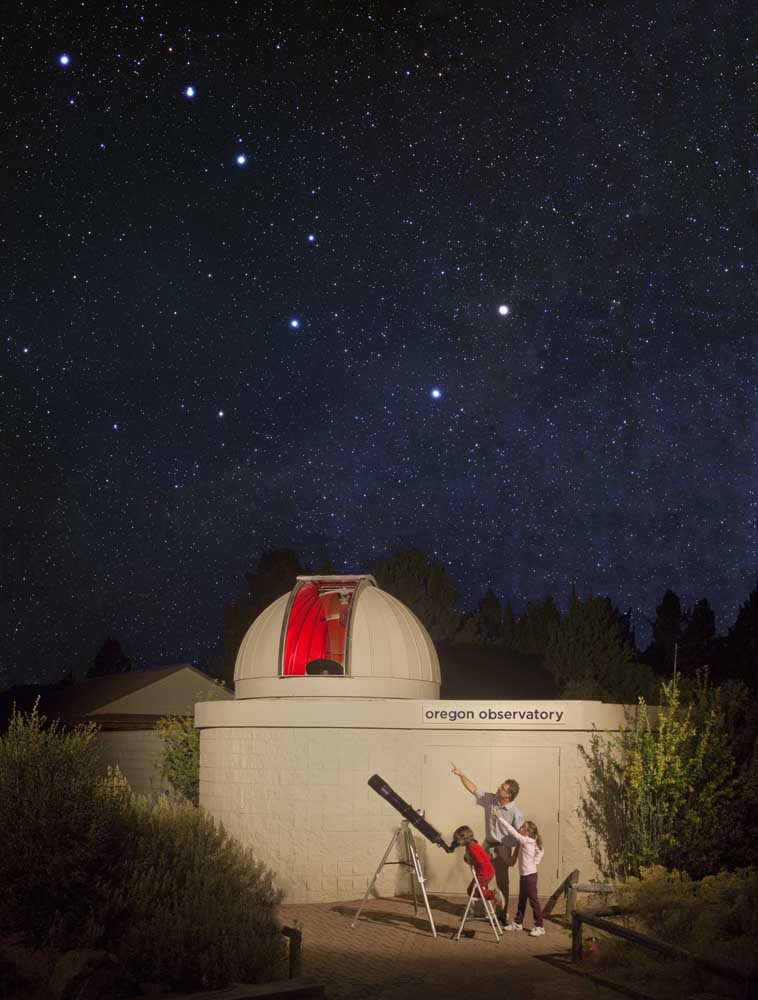Looking up
Published 12:00 am Friday, March 11, 2016

- Looking up
While most astronomical events are well-documented and anticipated, such as this summer’s transit of Mercury over the Sun, sometimes just being in the right place at the right time can result in stellar experiences. Don Barnes, 80, a longtime volunteer at the Oregon Observatory, recalls pointing out constellations to a tour group during an evening viewing at the Observatory when the unexpected happened.
“I happened to be outside with a group and a meteor so bright it was casting shadows appeared in that part of the sky,” said Barnes. “Seriously, you could see the shadows of people. It was reported all over Central Oregon.”
The High Desert is known for the quality of its stargazing — low light pollution, high elevation and generally clear weather combine to create an ideal environment for viewing the night sky.
“On a scale, it is eight out of 10, which is pretty good,” said Oregon Observatory Manager, Bob Grossfeld. “It is not perfect, but way better than most. We are in the top 10 percent for being able to see the night sky.”
The Observatory’s location on the Sunriver Nature Center and Oregon Observatory campus provides it with an additional plus. Sunriver has strict ordinances regarding light pollution, which help to create a richer night sky viewing experience.
“I think it is important that people who live in Central Oregon understand that we live in a place where we can enjoy the night sky in a way that others can’t,” said Grossfeld. “We have people visit from all over and they are shocked at what they are able to see here compared to what they can see at home.”
While a telescope is not necessary to enjoy the night sky, it can certainly enhance the experience. The Observatory is home to 25 high quality telescopes ranging in size from 4 to 30 inches — the largest collection of telescopes for public use in the country — all of which have been donated or loaned to the organization. A complete and impressive list and descriptions of the telescopes can be found online.
“We’ve got a large number of telescopes all looking at different objects, so you really have a wide range of things to look at,” said Barnes. “There is at least one of everything — planets, galaxies, globular star clusters, open star clusters, nebulas …”
As a 25-year volunteer with the Observatory, Barnes is a living example of the mission of the Sunriver Nature Center and Oregon Observatory, inspiring present and future generations to cherish and understand the natural world. After retiring to Sunriver in 1990 following a career as an electrician, Barnes helped to build the original dome building of the Observatory in 1991 and has been heavily involved with the organization ever since.
“I’ve slowed down, I only go four nights a week now,” said Barnes. “Thursday is my night to go fishing.”
When he is not fishing, it is a pretty sure bet Barnes will be at the Observatory helping guests learn how to position the telescopes to view objects in the sky, answering questions and sharing his knowledge with visitors ranging from those who have advanced degrees in astronomy to those who don’t know that the Sun is a star. He enjoys helping people learn about the sky, particularly when they share his enthusiasm for the topic, regardless of age.
“We had one young girl visit, she was around 8 years old and that particular summer we were looking at Jupiter,” said Barnes. “She learned how to position the telescope and was as happy as a clam. Her dad bought her a telescope, and the next summer she came back excited about looking at everything.”
This may well be the story of Kelsey Yocum, 26, who was 8 years old when she visited the Observatory for the first time, developing an enthusiasm for astronomy and for the team at the Observatory who introduced her to it. Yocum went on to get her own telescope and volunteered at the Observatory for years, eventually working there during the summers while she attended college. She credits the generosity and enthusiasm of the volunteers and staff at the Observatory for her lifelong love for astronomy.
“They took the time to teach me the basics as a kid and have been mentors ever since,” said Yocum. “I’ve grown up there and, not to sound too soppy, the Observatory at times feels like a home away from home.”
The Sunriver Nature Center and Oregon Observatory (the umbrella nonprofit organization that administers the Oregon Observatory) is in the process of expanding and updating the facility, and near-term plans for the Observatory include a second roll-off building. Long-term plans include the addition of a planetarium that also functions as a lecture hall and theatre. Current exhibits will be professionally redesigned, and several new solar telescopes may be added.
“Our long-range projects include a second roll-off roof which will allow for six more telescopes and give us space to put in more exhibits,” said Grossfeld. “They will be related directly to the solar system and rocketry.”
The added space will help the organization better meet the needs of the growing number of visitors — they currently average 10,000-12,000 visitors per year who come for a wide array of family-friendly activities including solar and evening viewing, classes, a lecture series and special events.
For those interested in a more private viewing experience, the Observatory is available to rent for parties and serious amateur astronomers, astrophotographers and researchers.
“One thing I feel it is important for people to know is that we are self-funded,” said Barnes. “We have no money from the resort or the homeowners, it is all donations and volunteers that keep it going.”
The best evening viewing at the Observatory is on clear, moonless nights, with the Milky Way stretching across the entire sky. Normally there are more than a dozen quality telescopes set up for public viewing, and staff and volunteers are on hand to teach how to use the equipment and answer questions.
A family-friendly presentation introducing astronomy and the cosmos is part of the evening program, as are guided tours of the constellations using green lasers that appear to touch the stars. Guests learn about some of the mythology associated with the constellations, and as long as the weather cooperates, view objects in the night sky and catch an occasional glimpse of the International Space Station or the flare of a passing satellite.
“Many visitors have a lot of fun seeing planets like Jupiter and Saturn, where you can see details such as the rings of Saturn and Jupiter’s Galilean moons — the four largest moons of Jupiter,” said Yocum. “But my favorites are the deep space objects — star clusters, nebulae and galaxies.”
Yocum’s personal favorite object in the night sky is one of the first that she learned how to find using a telescope, a huge globular star cluster — a ball of hundreds of thousands of stars — named M13. Also known as the Great Cluster in the constellation of Hercules, it is also a personal favorite of Barnes, who may have been one of the people who taught Yocum how to find it nearly two decades ago.
“You can see it most of the summer, and on a good dark night it looks like a handful of diamonds on black velvet,” said Barnes. “When the conditions are right it is just so spectacular.”
For Yocum and many others, the Observatory is not just a welcoming place full of friendly enthusiasts who are willing to share their knowledge and interests with everyone — it also represents one of the few places where the general public can learn about astronomy and space in a tangible way.
“Oftentimes astronomy facts or space news can feel like an abstract or distant thing,” said Yocum. “At the Observatory you have the opportunity to see the actual planets, star clusters, nebulas and galaxies with your own eyes. That is a special thing.”
For more information, visit www.oregonobservatory.org.








